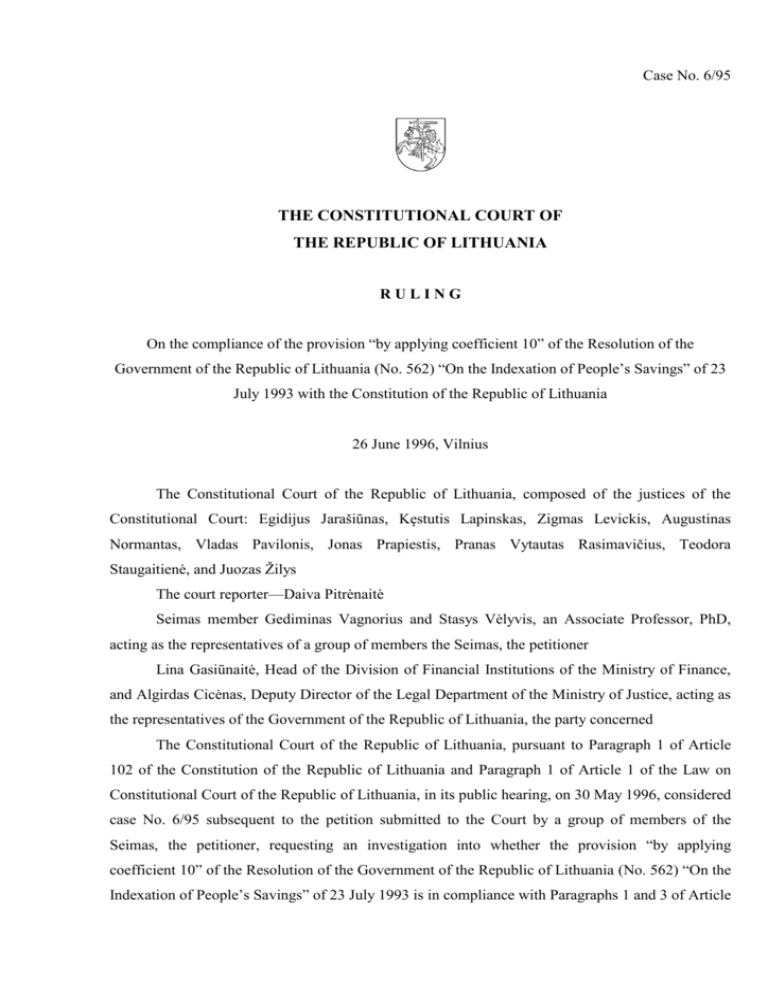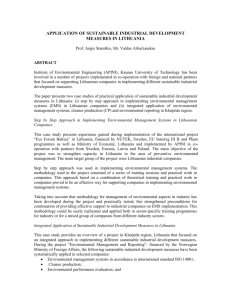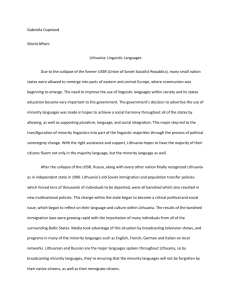Case No
advertisement

Case No. 6/95 THE CONSTITUTIONAL COURT OF THE REPUBLIC OF LITHUANIA RULING On the compliance of the provision “by applying coefficient 10” of the Resolution of the Government of the Republic of Lithuania (No. 562) “On the Indexation of People’s Savings” of 23 July 1993 with the Constitution of the Republic of Lithuania 26 June 1996, Vilnius The Constitutional Court of the Republic of Lithuania, composed of the justices of the Constitutional Court: Egidijus Jarašiūnas, Kęstutis Lapinskas, Zigmas Levickis, Augustinas Normantas, Vladas Pavilonis, Jonas Prapiestis, Pranas Vytautas Rasimavičius, Teodora Staugaitienė, and Juozas Žilys The court reporter—Daiva Pitrėnaitė Seimas member Gediminas Vagnorius and Stasys Vėlyvis, an Associate Professor, PhD, acting as the representatives of a group of members the Seimas, the petitioner Lina Gasiūnaitė, Head of the Division of Financial Institutions of the Ministry of Finance, and Algirdas Cicėnas, Deputy Director of the Legal Department of the Ministry of Justice, acting as the representatives of the Government of the Republic of Lithuania, the party concerned The Constitutional Court of the Republic of Lithuania, pursuant to Paragraph 1 of Article 102 of the Constitution of the Republic of Lithuania and Paragraph 1 of Article 1 of the Law on Constitutional Court of the Republic of Lithuania, in its public hearing, on 30 May 1996, considered case No. 6/95 subsequent to the petition submitted to the Court by a group of members of the Seimas, the petitioner, requesting an investigation into whether the provision “by applying coefficient 10” of the Resolution of the Government of the Republic of Lithuania (No. 562) “On the Indexation of People’s Savings” of 23 July 1993 is in compliance with Paragraphs 1 and 3 of Article 2 23 of the Constitution of the Republic of Lithuania. The Constitutional Court has established: I On 23 July 1993, the Government adopted the Resolution (No. 562) “On the Indexation of People’s Savings” (Official Gazette Valstybės žinios, 1993, Nos. 32-756, 65-1236; 1994, No. 761438; 1995, No. 3-41; hereinafter referred to as the impugned government resolution), Item 1 whereof establishes that state banks and State Insurance Office shall index by applying coefficient 10 the savings of citizens of the Republic of Lithuania, as well as those of persons who permanently live in the Republic of Lithuania, and those of rehabilitated persons who were deported from Lithuania and now live abroad. When the case was being prepared to the hearing of the Constitutional Court, as well as during the judicial investigation, the representatives of the petitioner grounded their request with the following arguments: 1. The impugned government resolution has established that the savings and insurance payments of the people of Lithuania which were accumulated until 26 February 1991 shall be indexed by applying coefficient 10, whilst this means that people’s deposits with their initial (actual) value are, in essence, confiscated, i.e., private property which was accumulated in the form of deposits is practically seized for no consideration. 2. There were more than 7 milliard roubles of the deposits of the people of Lithuania accumulated in savings banks and State insurance offices during the period of Soviet occupation. The savings banks did not dispose of these savings of the people, they merely received deposits and controlled their accounting. Soviet government would take people’s deposits in centralised manner as budgetary incomes and would utilise them through the budget for the purpose of various needs of the State. The representatives of the petitioner noted that the alienated funds did not disappear: they were invested into various branches of economy, thus, in Lithuania, about one third of state property was created which, in essence, belongs to individual persons, i.e., to all people, and not to the State because the funds of the aforesaid persons which were accumulated in savings banks in the form of deposits were materialised in state property that was created from them. 3. The representatives of the petitioner maintained that inflation did not destroy people’s deposits because deposits as credit resources in fact existed neither in 1990, nor later: they were converted into the property of state enterprises and organisations. Since there were not any people’s deposits in the Savings Bank (they had been utilised by Soviet government), thus, now it is possible 3 to compensate them by selling a corresponding share of state property, by indexing the deposits with the inflation coefficient, and thereby the initial value of the deposits could be restored. On the grounds of the data of the Department of Statistics, the representatives of the petitioner indicated that the inflation coefficient was 113.46% from 1 March 1991 until 1 July 1993, therefore, they made the conclusion that people’s savings in the form of deposits and insurance payments which were indicated in Item 1 of the impugned government resolution should have been indexed “by applying coefficient 113.46, and not coefficient 10”. 4. The representatives of the petitioner pointed out that, according to Articles 109 and 1091 of the Civil Code of the Republic of Lithuania, people’s deposits and other funds which could be identified with them and which are held in banks and other credit offices shall belong to these people by the right of private ownership. Besides, it is established in Paragraph 5 of Article 471 of the said code that “state shall guarantee security and payment of the funds of natural persons which are held in the accounts of state, state-stock or other state credit offices on the first demand of the person”. The decisions of the Seimas and the Government also point out that the possessions of the State guarantee that people’s deposits will not be lost. 5. The representatives of the petitioner, on the grounds of the provisions “property shall be inviolable” and “property may only be seized for the needs of society according to the procedure established by law and must be adequately compensated for” of Article 23 of the Constitution, indicated that these provisions are violated by the impugned government resolution as: 1) by not returning the deposits to people, the constitutional principle of inviolability of property is violated; 2) the savings are seized even though there exist no grounds indicated in Article 471 of the Civil Code to do so; 3) the impugned government resolution does not indicate for what needs of society people’s savings are seized; 4) the provision “must be adequately compensated for” is violated as 90% of people’s deposits are seized at no cost. 6. The representatives of the petitioner alleged: “The Government had (and has now) the possibility of restoring people’s savings by means of the existing state property and had to index people’s savings according to coefficients” which correspond the officially stated inflation indicators. The representatives of the petitioner indicated that, according to the data of the Department of Statistics, on 1 January 1994 there was non-privatised property for 1.83 milliard litas, whereas if this property were indexed by coefficient 10 as established in the impugned government resolution, its value would be 18.3 milliard litas. Approximately 8 milliard litas are needed to index the deposits in their actual value. In the opinion of the representatives of the petitioner, there exists non-privatised property of 4 enterprises for 10.5 milliard litas, i.e. this is more than needed to compensate the deposits in their actual value. Besides, they noted that the indexation coefficients established in the impugned government resolution are several times lower than they ought to be pursuant to the actual index of prices, therefore, if the existing non-privatised state property were indexed fairly, i.e., according to the indicators stated officially by the Department of Statistics, there would be much more state property than required to compensate people’s devaluated deposits in their actual value. II The representatives of the Government, the party concerned, presented the following counter-arguments when the case was being prepared for the Constitutional Court hearing, as well as during the judicial investigation. 1. The impugned government resolution to index people’s deposits accumulated until 26 February 1991 in state banks, as well as their insurance payments in the State Insurance Office, by applying coefficient 10 was adopted taking account of actual financial possibilities of accumulating the required funds to pay the compensations in cash but not in state property. It was established by the calculations of the Savings Bank of Lithuania, the Lithuanian Bank of Agriculture, the State Commercial Bank and the State Insurance Office that the total sum of people’s deposits and insurance payments by applying coefficient 10 is 539.8 million litas and that it must be paid during the period of 11 years. The Seimas by its Resolution (No. 1-338) “On the Indexation of People’s Savings” of 15 December 1993 (Official Gazette Valstybės žinios, 1993, No. 71-1329) approved of coefficient 10 which was established in the impugned government resolution and recognised that the savings, the added interests and calculated by the established manner compensations for savings are the internal loan of the State of the Republic of Lithuania to people. Moreover, this resolution recommended the Government to establish the Fund of Restoration and Compensation of Savings in which funds would be accumulated to repay the established compensations. 2. By its Resolution (No. 34) “On the Restoration of People’s Savings and on Compensation Payments in 1994” 21 February 1994 (Official Gazette Valstybės žinios, 1994, No. 7-115), the Government established the Fund of Restoration and Compensation of Savings the regulations whereof were approved by the Seimas by its Resolution “On the Approval of the Regulations of the Fund of the Restoration and Compensation of Savings” of 26 April 1994 (Official Gazette Valstybės žinios, 1994, No. 33-589). When implementing the aforesaid resolutions, 35.78 million litas were transferred from the said fund for compensation payments until 17 July 1995, whereas 163.5 million litas were assigned to pay compensations for the years of 1993–1994. 3. The representatives of the party concerned refuted the allegation of the representatives of 5 the petitioner that about one third of state property was created out of the seized savings of people. In their opinion, such an allegation is not grounded on any objective calculations because it is impossible to do so. As is known, people’s savings were used in centralised manner as budget income to finance various projects in the former republics of the Soviet Union. Therefore, it is impossible to establish what objects and in what republics of the former Soviet Union were built for the Lithuanian people’s seized savings accumulated in the savings banks. 4. The representatives of the party concerned pointed out that, by its Resolution (No. 554) “On the Internal Loan of the State of Lithuania, as Well as the Share of State Stock Capital in the Lithuanian Savings Bank” of 19 April 1995 (Official Gazette Valstybės žinios, 1995, No. 34-843), the Government commissioned the Ministry of Finance to sign an agreement with the Savings Bank concerning the internal loan of the State of Lithuania which appeared due to the seized savings by the Central Bank of the former USSR as well as the necessity to return the calculated and charged to accounts interests. The agreement between the Government and the Savings Bank was signed on 15 May 1995. In the opinion of the representatives of the party concerned, not only the devalued savings of depositors but also those of all entities of economy, as well as other property, should be compensated due to inflation. The funds accumulated in the Savings Bank until 26 January 1991 were in fact seized by the former Soviet Union and, until now, were not returned to Lithuania. The agreement regarding the returning of the seized savings of people has not been signed with Russian Federation yet. The Constitutional Court holds that: 1.1. On 11 March 1990, the Supreme Council of the Republic of Lithuania passed the Law “On the Provisional Basic Law of the Republic of Lithuania”. It confirmed the Provisional Basic Law of the Republic of Lithuania by Article 2 of the said law, whereas by Article 3 of the said law it established that such laws and other legal acts which had been in force until then shall be valid in the Republic of Lithuania which are in compliance with the Provisional Basic Law of the Republic of Lithuania. Thus, upon the reinstatement of the Independent State of Lithuania, for some time laws which had been in force until then, among them those regulating the legal status of people’s savings in savings banks, were valid in the legal system of Lithuania. It is established in Article 93 of the Provisional Basic Law of the Republic of Lithuania that the “the Government shall implement executive power in the Republic of Lithuania”, whereas Article 100 provides that the composition of the Government, its jurisdiction and principles of activity shall be established by the Law on the Government. The Supreme Council passed the Law 6 on the Government of the Republic of Lithuania on 22 March 1990 (Official Gazette Valstybės žinios, 1990, No. 11-330; hereinafter in the ruling referred to as the Law on the Government). It is established in Item 1 of Article 2 of the said law that the Government shall take concern for “preservation and augmentation of the property of the Republic, guarantee all property subjects freedom of economic activity, the variety of property forms, as well as their equality”, whereas in Article 15 it is stipulated that “pursuant to its jurisdiction, the Government shall take decisions regarding implementation of state policy in the spheres of money circulation and money”. 1.2. During the period of Soviet occupation, people’s savings in the form of deposits were accumulated in the state labour savings banks of the USSR (hereinafter in the ruling referred to as the savings banks). The savings banks constituted part of a unified, centralised, Union system of credit offices which was subordinate to the State Bank of the USSR. The activity of savings banks was regulated by the USSR laws, substatutory normative legal acts, directions and instructions of the State Bank of the USSR, as well as regulations of savings banks. The relations which appeared between savings banks and people due to the held deposits and the procedure of their utilisation were regulated by “The Regulations of State Labour Savings Banks of the USSR” (hereinafter in the ruling referred to as the Regulations) that were approved by the 11 July 1977 resolution No. 623 of the Soviet of Ministers of the USSR. The Regulations indicated that one of the main objectives of the savings banks is to provide people with an opportunity to preserve and accumulate savings in the savings banks, and to utilise the savings in the interests of economy. The savings of people of Lithuania which had been accumulated in the savings banks and other credit offices would be transferred in centralised manner to the budget of the Soviet Union. It was established in Item 5 of the Regulations that the security and privacy of savings or other valuable items as well as their payment on the first demand of the depositor shall be guaranteed by the state. It was provided for in Item 18 of the said Regulations that the depositor was entitled to dispose of his deposit. 2. Upon the reinstatement of the Independent State of Lithuania, the Soviet Union undertook military, political, and economic actions against Lithuania. Among them, actual seizure of savings of people of Lithuania which were accumulated in the savings banks was used as a means of economic and financial pressure. In such a situation, on 28 April 1990, the Government adopted the Resolution (No. 133) “Concerning the Measures to Stabilise the Activity of Lithuanian Economy as Well as Provision to People under the Situation of the Economic Blockade”, as well as the Resolution (No. 134) “Regarding Anti-blockade Measures to Regulate Money Circulation and to Manage Account Settling”. These resolutions attempted to ensure the functioning of national economy by the 7 foreseen economic measures. Item 1 of resolution No. 134 commissioned banks of the Republic of Lithuania, self-government bodies of cities and districts, to induce, in every way possible, concentration of people’s savings into deposits in the offices of the Lithuanian Savings Bank, as well as those of other banks. It was established that the Republic of Lithuania guarantees with its property that people’s deposits will not be lost. That corresponded the norm of Article 471 of the Civil Code that “the State shall guarantee privacy, security and payment of deposits on the first demand of the depositor”. This norm is valid at present, too. The guaranty of the Government that “deposits will not be lost”, concerned not only the deposits which were transferred to the Savings Bank or other banks’ offices already after resolution No. 134 of 28 April 1990 had been adopted but also those which had been put into the savings banks during the period of occupation and which could not be taken back by people as in fact the Soviet government seized them. Such a commitment was confirmed by the Government Resolution (No. 106) “On the Protection of People’s Savings as Well as Insurance Payments from the Devaluation Related with the Rise of Prices on This Occasion” of 28 March 1991. Item 1 of this resolution prescribed: “50% of deposits’ value shall be compensated to people of the Republic of Lithuania provided that the sum of 5000 roubles shall not be exceeded for one person, whereas the sum up to 7000 roubles shall not be exceeded for former political prisoners and deportees.” In like manner, and with the same sums, the devaluation of saved payments by life and pension insurance was compensated. The devaluation of deposits, as well as that of payments of life and pension insurance, was compensated according to the situation of 26 February 1991 by allocating corresponding compensation to acquire some of state property subject to privatisation. The fact that people’s deposits, accumulated until 26 February 1991 and after, would not be lost and be exchanged into the national currency on favourable conditions was also confirmed by the Government Resolution (No. 67) “On Inducing People to Sell Livestock Products to the State During Winter and Spring Months” of 31 January 1992. It was established in Item 2 of Paragraph 1 of this resolution that a favourable rate of exchange into the national currency shall be applied to the means transferred either into individual deposit or individual farmers’ clearing accounts (by equating these means to the inventoried 26 February 1991 deposits with the rate 1 to 5 according to the prices’ rise index). It should be noted that in the aforementioned resolutions the commitment of the Government is expressed in general statements (“the deposits will not be lost”, “the deposits will not be lost and be exchanged into the national currency on favourable conditions”, etc.) but it was not indicated, however, on the grounds of which particular criteria, in what size, by what manner and during what time period people’s deposits accumulated in the Savings Bank or other credit offices will be 8 compensated. On 5 November 1991, the Supreme Council passed the Republic of Lithuania’s Law on Issuing Currency Paragraph 3 of Article 3 whereof stipulated that “the Government of the Republic of Lithuania, until the complete withdrawal of coupons from circulation, shall establish the size and procedure of the compensation of the devalued savings of people possessed until 26 February 1991 and held in the Lithuanian Savings Bank”. Thus, this law once again confirmed the right of the Government to establish the size of the devalued deposits and the procedure of their payment (Official Gazette Valstybės žinios, 1991, No. 33-896; 1993, Nos. 12-297, 27-622). From the mentioned above, as well as pursuant to the Provisional Basic Law of the Republic of Lithuania, the Law on the Government of the Republic of Lithuania (adopted in 1990), the Republic of Lithuania’s Law on Issuing Currency and other legal acts, the conclusion should be made that the Government was entitled to establish the size of the compensation and the procedure of its payment. 3.1. The Constitution of the Republic of Lithuania was adopted in the referendum on 25 October 1992. It is established in Article 128 of the Constitution that decisions concerning state loans and other basic property liabilities of the State shall be adopted by the Seimas on the recommendation of the Government. Article 2 of the Republic of Lithuania’s Law on the Procedure for the Enforcement of the Constitution of the Republic of Lithuania stipulates that “laws, other legal acts, or parts thereof which were in effect on the territory of the Republic of Lithuania prior to the adoption of the Constitution of the Republic of Lithuania, shall be effective provided they do not contradict the Constitution and this Law, and shall remain effective until they are either declared null and void or co-ordinated with the provisions of the Constitution”. This means that the legal acts of the Supreme Council and the Government whereby it was pledged to compensate the deposits of people of Lithuania and which were passed prior to the adoption of the Constitution are also mandatory for the institutions of authority and governance after the Constitution went into effect. The permanence of these commitments is confirmed by subsequently adopted legal acts by the Seimas and the Government, too. The Seimas recognised in Item 2 of its Resolution (No. 1-338) “On the Indexation of People’s Savings” of 15 December 1993 that “people’s deposits accumulated until 1 January 1991, as well as the calculated interests for the deposits, and the compensations of people’s savings and insurance payments calculated in the manner prescribed in Item 1 of this Resolution shall be internal loan of the State of the Republic of Lithuania to people”. The Seimas, by this resolution, while 9 fulfilling the provision of Article 128 of the Constitution, implemented the right conferred to it and recognised that compensation for people’s savings and insurance payments is internal loan of the State of the Republic of Lithuania to people (Official Gazette Valstybės žinios, 1993, No. 71-1329). It was established in the said resolution that by assessing financial capacity of the State the Seimas took the decision to compensate people’s savings in 1994 according to the then in effect government resolutions (No. 562 adopted on 23 July 1993, and No. 834 adopted on 12 November 1993). On 23 July 1993, while following the Republic of Lithuania’s Law on Issuing Currency which was passed by the Supreme Council on 5 November 1991 and fulfilling the Litas Committee’s Resolution “On Issuing the National Currency and Withdrawing Temporary Currency—Coupons—from Circulation” of 14 June 1993, the Government adopted its Resolution No. (562) “On the Indexation of People’s Savings”. In the preamble of the aforesaid resolution it was indicated that the Government takes into consideration the grave economic and financial situation of the Republic of Lithuania, therefore, in Item 1 it was provided that state banks and the State Insurance Office shall index by applying coefficient 10 the savings of citizens of the Republic of Lithuania, as well as those of persons who permanently live in the Republic of Lithuania, and those of rehabilitated persons who were exiled from Lithuania and now live abroad. Items 1.1, 1.2, 1.3, 1.4, and 1.5 of the impugned government resolution established the compensation procedure of people’s accumulated savings. The said items established the dates taking account of which newly consigned deposits or the remainder subject to compensation of prior consigned deposits had to be calculated. It was established in Item 2 of this resolution that people’s deposits accumulated in state banks until 1 June 1992, shall be indexed by applying coefficient 2 pursuant to the procedure provided for in the Government Resolution (No. 67) “On Inducing People to Sell Livestock Products to the State During Winter and Spring Months” of 31 January 1992 provided that the remainder of these deposits had not changed until 24 June 1993. Furthermore, it was indicated that the funds received for sold farm products until 1 June 1992 and which were included into people’s accounts overdue shall be indexed by applying coefficient 2 (Official Gazette Valstybės žinios, 1992, No. 10-270; 1993, No. 65-1236). Thus, the Seimas in fact agreed that the Government by its resolutions in different periods of time established different size of savings’ compensation. 3.2. When implementing the Seimas Resolution “On the Indexation of People’s Savings” of 15 December 1993, the Government adopted its Resolution (No. 34) “On the Restoration of People’s Savings and on Compensation Payments in 1994” of 21 January 1994. It was provided for 10 in Item 1 of this resolution to form a particular Fund of Restoration and Compensation of Savings. Moreover, it was recognised in Item 3 of the aforementioned resolution that the internal loan of the State of the Republic of Lithuania to the Lithuanian Savings Bank shall comprise of people’s deposits accumulated in the bank until 1 January 1991 and seized by the former Soviet Union at the same time, whereas in Item 3.3 the provision of resolution No. 562 of 23 July 1993 was reiterated that compensations to people for accumulated deposits and insurance payments shall be calculated by applying indexation coefficient 10. By its Resolution “On the Approval of the Regulations of the Fund of the Restoration and Compensation of Savings” of 26 April 1994, the Seimas approved the Regulations of the Fund of the Restoration and Compensation of Savings following which the funds are accumulated to compensate people’s deposits. It is indicated in Paragraph 2 of the said resolution that one of the sources of forming the Fund of Restoration and Compensation of Savings is compensations for the seized deposits of the Central Savings Bank of the former USSR acquired upon signing a corresponding agreement with Russian Federation. Besides, on 15 May 1995, the Government and the Lithuanian Savings Bank signed an agreement where the Government committed itself to cover the loan to this bank for the loans being returned to people during the period of 10 years. Thus, upon adoption of the Constitution, the State, however, did not decline its initial commitments to compensate people their deposits even though the legally grounded scope of deposits’ protection was not established. 4. The representatives of the petitioner, on the grounds of the provision “property shall be inviolable” of Paragraph 1 of Article 23 of the Constitution, as well as that of Paragraph 3 which stipulates “property may only be seized for the needs of society according to the procedure established by law and must be adequately compensated for” alleged that the impugned government resolution violates property rights of the depositors. It is established in Paragraph 1 of Article 1091 of the Civil Code that the object of private ownership may be any property without limiting its size provided that this code and other laws do not prohibit holding this property in accordance with the right to private ownership. According to the doctrine of law, the right of claim is a type of property. Therefore, the right of claim, as well as any other property, is the object of private ownership. Thus, the object of the right of the depositor to ownership is the right of claim, whereas the object of the right of tangible property is particularised property. The owner’s property rights are protected to the same extent irrespective of the object of the right to private ownership providing the law does not establish any exceptions. In view of what has been mentioned above, the conclusion should be made that the subjective rights of claim of the owner must be protected along with his rights to tangible property 11 following the principles of protection developed in property law. The representatives of the petitioner interpreted the notions “the State guarantees that people’s deposits will not be lost”, “the State ensures the security of deposits” as the commitment of the State to preserve the value of the deposits. The notion “security of deposits” which is used in legal acts is a juridical notion which is interpreted as safekeeping deposits in credit offices which are responsible for the preservation of the deposits’ nominal value and which guarantee their payment on the first demand of the depositor with the interest established by law or agreement of the parties. “The preservation of value of the deposits” is interpreted as an economic category. Devaluation of deposits, as a rule, is caused by objective economic developments (as well as inflation) which are not dependent upon the will of the credit office that keeps people’s deposits. Thus, the notions “security of deposits” and “the preservation of value of the deposits” cannot be identified according to the juridical and economic meaning of their content. Deposits, in part, may be preserved from devaluation by paying interests for them, by forming individual or joint insurance systems of private banks, etc. However, even though the deposit insurance system is created for the purpose of deposit protection, as a rule, only the payment of nominal value sum is guaranteed but not compensation of the losses suffered because of inflation. The representatives of the petitioner identified insufficient compensation with seizure (confiscation) of deposits provided for in Paragraph 4 of Article 471 of the Civil Code. However, this interpretation means the identification of two notions which are different in their legal characteristics. Paragraph 4 of Article 471 indicates legal grounds in the presence of which deposits may be exacted or confiscated, i.e., it indicates when exceptions can be made from the principle of deposits’ security guaranteed by the State. Meanwhile, devaluation of deposits because of inflation is an economic phenomenon. 5. In view of the arguments set forth, the conclusion should be made that the State must fulfil its commitments to people and compensate the devaluated deposits. The establishment of the size of compensation is a prerogative of the Seimas as it is established in Article 128 of the Constitution that decisions concerning state loans and other basic property liabilities of the State shall be adopted by the Seimas on the recommendation of the Government. The Constitutional Court also notes that the Seimas is not bound by previously adopted legal acts, therefore, by taking account of actual possibilities, it may establish other compensation coefficients of people’s devalued deposits and insurance payments. In view of the arguments set forth, the Constitutional Court has made the conclusion that there are not any sufficient legal arguments to ground as to what size of the indexation coefficient 12 must be held as corresponding the constitutional principle of inviolability of property, therefore, the provision of the impugned government resolution may not be held as contradicting Article 23 of the Constitution. Conforming to Article 102 of the Constitution of the Republic of Lithuania and Articles 53, 54, 55 and 56 of the Law on the Constitutional Court of the Republic of Lithuania, the Constitutional Court of the Republic of Lithuania gives the following ruling: To recognise that the provision “by applying coefficient 10” of the Resolution of the Government of the Republic of Lithuania (No. 562) “On the Indexation of People’s Savings” of 23 July 1993 is in compliance with the Constitution of the Republic of Lithuania. This ruling of the Constitutional Court is final and not subject to appeal. The ruling is pronounced in the name of the Republic of Lithuania. Justices of the Constitutional Court: Egidijus Jarašiūnas Kęstutis Lapinskas Zigmas Levickis Augustinas Normantas Vladas Pavilonis Jonas Prapiestis Pranas Vytautas Rasimavičius Teodora Staugaitienė Juozas Žilys







